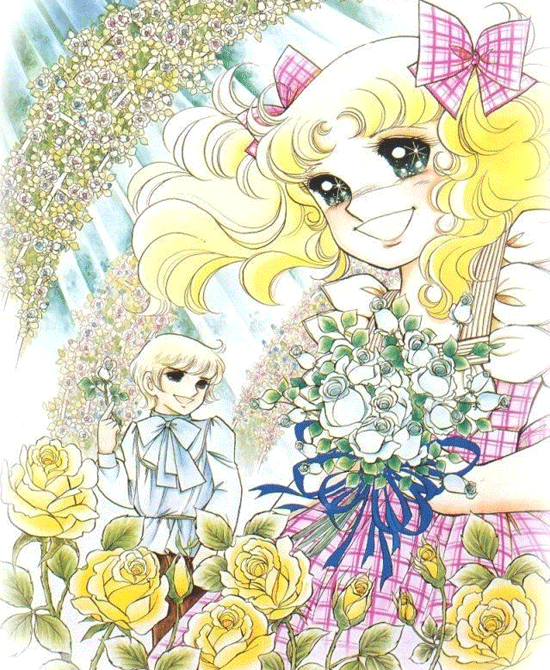In the mid-1970s, the import of Kyoko Mizuki’s Candy Candy into South Korea marked a new era for manhwa read by the female Korean youth. The enormous success of the imported shojo manga (which originally ran in Japan from 1975 to 1979) in South Korea changed all artistic aspects of soonjung manhwa seemingly overnight.
Visually, the deluge of imports introduced the now quintessential exquisitely-dressed feminine male character with blond (often long) hair and fair skin. Works such as Rose of Versailles and The Window of Orpheus extensively used Europe as source material. For example, Rose of Versailles takes place during revolution-era France and a features fictional character Oscar, a young woman in man’s garb, as well as historical characters such as Marie Antoinette, her husband King Louis the 16th, her lover Axel von Fersen, and her mother the Queen of Austria. The manga tells stories of love and conflict in a realistic and vivid manner: this harmonious combination of the fictional and historical opened the eyes of Korean readers, who realized that such narratives could be expressed through manhwa.

In Candy Candy, the orphaned freckled, charming, bright girl, who has blond pigtailed hair and skin so fair that she is named Candy White by the orphan home sister, grows up in Michigan in the early 20th century, and is eventually adopted by a wealthy Irishman Uncle William. Candy is lavished with love and attention from beautiful male characters Anthony, Archie, Stear, Terry, and Albert. The manga narrative focuses on the protagonist’s various light-hearted episodes with these male characters of diverse personality traits. Candy remains nearly universally loveable, except to those few minor characters who are wealthy, but jealous of her. This storyline soon became a core formula of soonjung manhwa itself, and the mentioned male characters became the very archetypes of male figures in soonjung manhwa.

As a deluge of shojo manga of similar ilk were imported after the enormous popularity of Candy Candy, and Rose of Versailles, many Korean manhwa writers, such as Jung Young-Suk, Kim Young-Suk, Hwang Su-Jin plagiarized shojo manga works completely from beginning to finish. Korean manhwa had been influenced by Japanese manga since the beginning of 1960s, but never had entire works been systematically copied in such a manner: the only thing now that differentiated the Japanese original from the Korean copy seemed to be the written language. Despite the heavy criticisms of plagiarism, Koreans still paid money to read these works: in the second half of the 1970s, all manhwa produced for female audience looked virtually identical and contained similar plots.
Sohn Sang-Ik discusses the glaring trend in 1970s shojo manga to locate narratives in the West, particularly in Europe. Even before Japan ended its Isolationist Policy in the 19th century, it had started employing Dutch technology as early as the beginning of the 16th century. During the Japanese invasions of Korea from 1592 to 1598, Japan had already been using guns imported from Europe. During the Meiji Restoration that began in 1868, Japan not only modernized the government based on a European model, such as writing the Meiji Constitutioin based on that of the Weimar Republic, but also urged the Japanese people to adopt lifestyles akin to those of Europeans. Government officials began to don Western style tuxedos instead of kimonos, and outright asked Japanese people to do the same. Scholar Fukuzawa Yukichi strongly advocated that Japan distance itself from Asia and become part of Europe, and was met with general agreement.
According to Sohn, Japanese people aspired to be much like the Europeans, but were also deeply aware that no matter how much the Japanese imitated the Europeans, that Japan could not be part of Europe. We can read in 1970s shojo manga this aspiration to be like Europe: central to the manga are the story location and visual details in costume and lifestyle. Sohn calls this desperate aspiration as a complex. Further, Sohn posits that when Korean manhwa writers unabashedly copy such works (most obviously for the reason that it will sell), the Europe complex suggested within the manga may be unknowingly planted in Korean readers. However, even up to the time of Sohn’s writing in 1998, Korean soonjung manhwa artists who heavily borrowed the aesthetic elements and narrative structure of 1970s shojo manga claimed that much of soonjung manhwa artistically originates from Japan, and that sticking to this original is essential. Sohn strongly implies that this outright copying instills a paralyzed world view.
As formulaic shojo manga lookalikes drawn by Korean artists became rampant in the mid-1970s, soonjung manhwa that did not feature the trope of white blond protagonist and equally exquisite male characters essentially disappeared until the early 1980s. However, different developments in manhwa outside of the soonjung category at the turn of the decade would bring new momentum that would contribute to the creation of Hani in 1985.
Compiled from:
Choi, Yeol. The history of Korean cartoons 한국만화의 역사. Seoul: Yeolhwadang, 1995. ISBN 8930126030
Park, In-ha. Nuga Kʻaendi rŭl moham haenna 누가 캔디 를 모함 했나 : 박 인하 의 순정 만화 맛있게 읽기. Seoul: Sallim, 2000. ISBN 8952200438
Park In-Ha, and Kim Nak-Ho. Han’guk hyŏndae manhwasa, 1945-2010 한국 현대 만화사, 1945-2010. Seoul: Tubo CMC, 2012. ISBN 9788996503064
Sohn, Sang-ik. Hanʼguk manhwa tʻongsa (1945 to present) 한국 만화 통사 : 문화사적 관점 에서 본 한국 만화 의 역사 와 이론 : 선사 시대 부터 1945년 까지. Seoul: Sigongsa, 1998. ISBN 8972598739